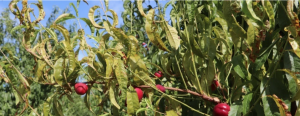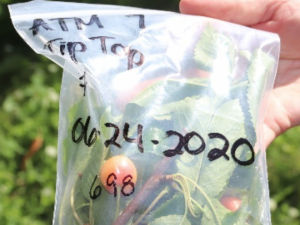Written by Cody Molnar, WSU Extension; Scott Harper, WSU Plant Pathology; Tianna DuPont, WSU Extension. July 2020

Little cherry virus 1 (LChV1), Little cherry virus 2 (LChV2) and X-disease phytoplasma cause very similar diseases often described as ‘Little Cherry’ or ‘X-disease.’ Diseased trees have small, poor colored fruit. Early detection and tree removal are essential to reduce the spread of the disease. Infected trees spread the pathogen to neighboring trees. Infected trees cannot be cured and MUST be removed entirely.
Major Symptoms
- Small and misshapen fruit.
- Poor taste and pale color.
- Symptoms may be found on only a few cherries on a single limb in early stages of disease.
- More limbs throughout the tree become affected as the disease progresses.
- Symptoms are most visible when cherries are ripe, with normal fruit for comparison.
- There are generally no major symptoms on the rest of the tree.

Rainier cherries with X-disease phytoplasma. See small, light colored cherries upper left compared to yellow with blush healthy looking fruit bottom right. Photo credit C. Molnar, WSU Extension.

A symptomatic cluster (right) of cherries next to healthy cherries (left) on Bing. Photo credit T. DuPont, WSU Extension.

Symptomatic cherries with X-disease, shown above, can be mistaken for unripe fruit. Photo credit C. Molnar, WSU Extension.
X-disease Symptoms in Other Stone Fruits
In peaches, plums, nectarines and apricots, X-disease can cause yellowing, curling, and small holes in leaves, called shothole, as well as small, deformed fruit.

X-disease phytoplasma in nectarine. Note the curled, yellow leaves (center) that appear only on the affected branch. Photo credit T. DuPont, WSU Extension.
Sampling
Confirmation of any of these pathogens is done through molecular testing.
1. Take four 5-inch cuttings from symptomatic limbs with leaves, stems and fruit.
 2. Make sure samples are clearly labeled with location or name, variety, and date. Include sample numbers if you are submitting multiple samples at once.
2. Make sure samples are clearly labeled with location or name, variety, and date. Include sample numbers if you are submitting multiple samples at once.
3. Keep tissue moist and cool (e.g. package with a cold pack)
4. Send to a lab for molecular testing. List of Labs testing for Little Cherry Virus and X-disease Phytoplasma
Contacts
Cody Molnar, WSU Extension ITT Coordinator
cody.molnar@wsu.edu
(509) 574-1595
Controls
There is no cure for little cherry and an infected tree will remain infected for the rest of its life. Symptoms will continue to worsen until most or all of the tree is affected. There are no treatments or products that have been shown to ’cure’ the phytoplasma or the virus.
Remove infected trees!
Infected trees are a source of disease for the whole neighborhood and must be removed. Removing affected branches does not appear to reduce or eliminate the disease.
Use Pathogen-Free Planting Sources:
Trees must be obtained from pathogen-free planting stock. Nursery trees can be free of symptoms and still be infected.
Control of this disease requires a community-wide effort. What your neighbor does or doesn’t do, affects you (and vice versa). Prompt removal of infected trees is the only way to stop the spread of these diseases.
References
- Little Cherry Disease
- X-disease Phytoplasma (Western-X)
- Jelkmann and Eastwell (2011) Little cherry virus-1 and -2. In: Virus and virus-like diseases of pome and stone fruits. APS Press, Minnesota, MN. Hort. 1058: 121-128.
- Bixby-Brosi, AJ, E Beers. 2017. Chemical control of grape mealybug, 2016. Arthropod Management Tests. 42 (1).
- Bixby-Brosi, AJ, E Beers. 2015. Chemical control of apple mealybug, 2014. Arthropod Management Tests. 40 (1).
- UCIPM 2015. Cherry Leafhopper, Fieberiella florii. Grant, J.A., Caprile, J.L., Coates, W.W., Van Steenwyk, R.A., Daane, K.M.
- UC IPM Pest Management Guidelines: Cherry. UC ANR Publication 3440.
- Van Steenwyk, R.A., Havens, D.M., Freeman, R. 1990. Evaluation of Trap Types for Two Vectors of Western X Disease: Colladonus montanus and Fieberiella florri. Journal of Economic Entomology. 83: pg 2279
- Purcell, A.H., Elkinton, J. 1980. A Comparison of Sampling Methods for Leafhopper Vectors of X Disease in California Cherry Orchards. Journal of Economic Entomology 73: 854-880.
- Purcell, A.H. 1987. Buckskin Disease of Cherry. California Agriculture.
